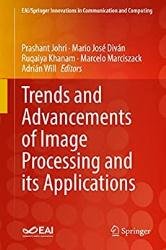 Название: Trends and Advancements of Image Processing and Its Applications
Название: Trends and Advancements of Image Processing and Its ApplicationsАвтор: Prashant Johri, Mario Jose Divan, Ruqaiya Khanam
Издательство: Springer
Серия: EAI/Springer Innovations in Communication and Computing
Год: 2022
Страниц: 306
Язык: английский
Формат: pdf (true)
Размер: 11.2 MB
Image processing is a great tool for many applications in our day-to-day life. Anyone could be captivated by the variety of forms, colors, textures, and motion among other perceptible aspects in the world. Human beings have a great ability to acquire, integrate, and interpret the information surrounding them. It is a challenging task to impart these capabilities to a machine in a way to interpret the visual information deeply embedded in a still image, moving image, video, and graphics in the sensory world. As a result, there is a lot of application areas of digital image processing, such as multimedia computing, biomedical imaging, biometrics, security image data communication, pattern recognition, texture understanding, remote sensing, and image compression content-based image retrieval.
This book is intended to cover current technological innovations and applications in the emerging field of image processing and analysis techniques with application in the clinical industry, remote sensing, forensics, astronomy, manufacturing, defense, and many more that depend on image storage, display, and information disclosure about the world around us. The book presents the concepts and techniques of remote sensing, such as image mining and geographical and agricultural resources, medical image detection and diagnoses, image recognition and analysis, Artificial Intelligence (AI), computer vision, Machine Learning (ML), Deep Learning-based image analysis, pattern recognition and capsule networks in object tracking, remote sensing, moving object tracking, and wavelet transformation.
Machine Learning (ML) is an Artificial Intelligence research field that studies the development of methods capable of extracting concepts (knowledge) from data samples. In general, ML algorithms are used in order to generate classifiers for a set of examples. Classification means the process of assigning, to a given data, the label of one (or more) class to which it belongs. In this sense, ML techniques are used to induce a classifier that, based on examples, is able to predict the class of new data of the amount in which it was trained.
Machine Learning approaches have evolved into deep learning approaches, which are a more robust and efficient way of dealing with the huge amounts of data generated from modern discovery approaches. However, deep neural networks, especially convolutional neural networks (CNNs) that work with images, have many layers and connections, making them computationally complex for the complete training of the network. However, a solution called transfer learning can be applied to help with this problem. The idea is to use prior knowledge to solve similar problems, as humans do.
The book targets undergraduate, graduate, and post-graduate students, researchers, academicians, policymakers, government officials, academicians, technocrats, industry research professionals who are currently working in the field of academic research, and the research industry to improve the lifespan of the general public.
The book is organized into 16 chapters. Chapter 1 describes the application of convolutional neural network (CNN) for classifying diseases based on computerized tomography scans. Chapter 2 outlines challenges related to image processing on mobile devices. Chapter 3 synthesizes a proposal applied to Smart City, using Internet of Things (IoT) and image processing. Chapter 4 proposes an application of artificial intelligence (AI) for dental image analysis. Chapter 5 analyzes the feature extraction techniques towards image processing of the plant extracts. Chapter 6 proposes a median filter based on entropy to remove noise in images. Chapters 7 and 8 describe the application of Deep Learning models for predicting diseases. Chapter 9 addresses an automatic bean classification system based on visual features. Chapter 10 describes a supervised model to classify human sperm head. Chapter 11 proposes the future contribution of computational vision in the detection of maturity states of medicinal cannabis in Colombia. Chapter 12 describes the detection of brain tumor region based on magnetic resonance images (MRI) using clustering algorithms. Chapter 13 proposes the use of CNN for estimating human posture through pictures. Chapter 14 addresses a human skin detection technique supported by color models. Chapter 15 proposes a study of improved methods on image inpainting.
- Presents developments of current research in various areas of image processing;
- Includes applications of image processing in remote sensing, astronomy, and manufacturing;
- Pertains to researchers, academics, students, and practitioners in image processing.